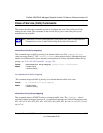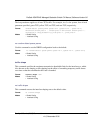
ProSafe XSM7224S Managed Stackable Switch CLI Manual, Software Version 9.0
Quality of Service (QoS) Commands 5-10
v1.0, November 2010
a. Creating and deleting classes.
b. Defining match criteria for a class.
2. Policy
a. Creating and deleting policies
b. Associating classes with a policy
c. Defining policy statements for a policy/class combination
3. Service
a. Adding and removing a policy to/from an inbound interface
The DiffServ class defines the packet filtering criteria. The attributes of a DiffServ policy define
the way the switch processes packets. You can define policy attributes on a per-class instance
basis. The switch applies these attributes when a match occurs.
Packet processing begins when the switch tests the match criteria for a packet. The switch applies
a policy to a packet when it finds a class match within that policy.
The following rules apply when you create a DiffServ class:
• Each class can contain a maximum of one referenced (nested) class
• Class definitions do not support hierarchical service policies
A given class definition can contain a maximum of one reference to another class. You can
combine the reference with other match criteria. The referenced class is truly a reference and not a
copy since additions to a referenced class affect all classes that reference it. Changes to any class
definition currently referenced by any other class must result in valid class definitions for all
derived classes, otherwise the switch rejects the change. You can remove a class reference from a
class definition.
The only way to remove an individual match criterion from an existing class definition is to delete
the class and re-create it.
Note: The mark possibilities for policing include CoS, IP DSCP, and IP Precedence.
While the latter two are only meaningful for IP packet types, CoS marking is
allowed for both IP and non-IP packets, since it updates the 802.1p user priority
field contained in the VLAN tag of the layer 2 packet header.


















